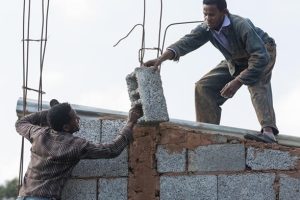
“መጣና በአመቱ ኧረ እንደምን ሰነበቱ!” “Here we come again after a year. How have you been? This is one of the lines that a group of Ethiopian children sing on the streets of Addis Ababa and the doorsteps of everyone when the rainy season comes to an end the annual Buhe festival comes.
On the eve of the festival and on the actual day, that is August 18 and 19, (Nehase 12 and 13 in Ethiopian calendar) children of same age, of course boys, get together to celebrate the festival of Buhe one of the religious festival that is celebrated by followers of the Ethiopian Orthodox Tewahido community to commemorate the Transfiguration of Jesus.
Days before the actual day of the celebration, young boys form groups and prepare items that are needed to celebrate Buhe. Decorated sticks, Jiraf (bigger whip) that is made from braided tree fibers and produce a loud sound that would be heard from a distance; musical instruments that look like Senatsel or Sistrum and Tirumba, trumpet like item, among others that are needed to make the performance more alluring. They also designate a leader who leads the choir – “Hoya Hoye”.
Children, especially boys, eagerly wait for the annual Buhe festival and that is why ‘Buhe’ is commonly known as a children’s holiday. As the festival is celebrated annually during the school-off period, children utilize this opportunity to be well-prepared to mark it colorfully. In the capital Addis Ababa, starting from the eve to the actual day of Buhe, children will sing the common Buhe songs and their own poems by moving from one house to the next.
They sing songs of admiration; extend best wishes of success and peace for any individual on their way. Presenting outstanding poems, incorporating the best sound of Tsinasel, Tirumba and Jiraf, enable the children to be well admired by the community and win more rewards. They will collect Mulmul bread and money as rewards which they share at the end of the festival.
The following is one of the poems of Buhe boys.
“የአንተ ጅራፍ ለከስካሳ
የኔ ጅራፍ አንበሳ
ስማው ስማው ሲያገሳ!”
Literally translated as;
Your Jiraf the weak
Mine Jiraf the lion
Listen to it roaring.
Roaring Jiraf is one of the outstanding manifestations of Buhe festival. Children will compete with the sounds and decoration of their Jirafs. Experts from the Ethiopian Orthodox Tewahido Church (EOTC) express that the sounds of Jiraf during the Buhe season represents the sound of Christ from the sky. The cultural aspect of the Jiraf sound on the other hand represents the coming of a New Year. Therefore, it heralds a new hope and motivates people to be ready for the New Year.
Addis Ababa City Administration Culture and Tourism Bureau Senior Heritage Expert Memhir Mekibib Gebremariam told The Ethiopian Herald that Buhe festival could be a tangible source of income if developed and utilized properly for tourism. Buhe festival is among the leading festivals that have great potential to showcase ancient Ethiopia’s religious and cultural values.
According to him, Buhe festival has enormous religious, cultural, social, and economic values. The festival creates a sense of ownership among the new generation and to contribute their part in the effort exerted to conserve intangible heritages that are inherited from the ancestors through oral traditions. Moreover, every stakeholder should collaborate to inscribe the Buhe cultural festival under the United Nations Educational, Scientific, and Cultural Organization (UNESCO) prestigious heritage list.
“Buhe festival is among the country’s outstanding intangible cultural heritages. Buhe and other festivals’ celebration teaches the new generation to be ethical, punctual, and responsible citizens in their future endeavors. It also strengthens the value of togetherness and reinforces the culture of sharing. Thus, the message of Buhe is extraordinary for children,” he said.
As to him, various studies have been conducted on the preconditions that enable Buhe’s cultural celebration to be inscribed as a national heritage. The Authority for Research and Conservation of the Cultural Heritage (ARCCH) has done successive research undertakings in various parts of the country where the holiday is marked colorfully. The Buhe celebration is more known in Menz, Wollo, Gondar (Debre Tabor) and Addis Ababa, he said.
As to him, the registration of this cultural celebration as a national heritage will have a significant socio-economic role. In addition, registration and conservation of the country’s diversified intangible cultural heritages is important to promote the country’s tourism sector through building the national image among the international community, he noted. Celebrating Buhe festival while keeping its spiritual and cultural values immensely contributes to inheriting the forefathers /foremother’s cultural wisdom and arts.
Currently, the Ethiopian government has given due priority to develop the tourism sector and generate a tangible income from the sector. Thus, the media, EOTC, youths, children, parents, heritage experts, historians, and other stakeholders are expected to fulfill their roles towards conserving intangible cultural heritages. Every stakeholder is expected to work hand in hand to develop Buhe festival for tourism, he stressed.
“The Ministry of Education should also include Buhe and other cultural festivals in the education curriculum. Teaching children about the country’s significant cultural festivals will motivate them to keep the country’s ancient historical heritages. The new generation will also give more attention to their own cultural attires, songs, dances, among others if taught in schools very well.”
In Ethiopia, Buhe is believed to be the turning point from the high rainfall season to bright sunshine and lovely month, September which is the first month of the Ethiopian New Year. There is a widespread belief that there will be no more heavy rain, flood, and landslide after Buhe is celebrated.
Memhir Mekibib further said that Chibo (torch) is the other element of the Buhe celebration that gives a more enticing vibe to the festival. The Chibo portrays the new and bright hope coming after the rainy season. Children will also entertain the religious and cultural values of torching Chibo. They watch everything practically since their infant age and learned how to celebrate Buhe together by sharing Mulmul, money and other materials.
What is more, being adorned with their own cultural dressing is also a big aspect of the Buhe boys. Elders will praise them on their ways while adorned with various Ethiopian Nations, Nationalities and Peoples’ cultural dressing. Therefore, the new generation will understand the importance of giving value to own culture and wisdom, he emphasized.
BY TEWODROS KASSA
THE ETHIOPIAN HERALD SATURDAY 19 AUGUST 2023





